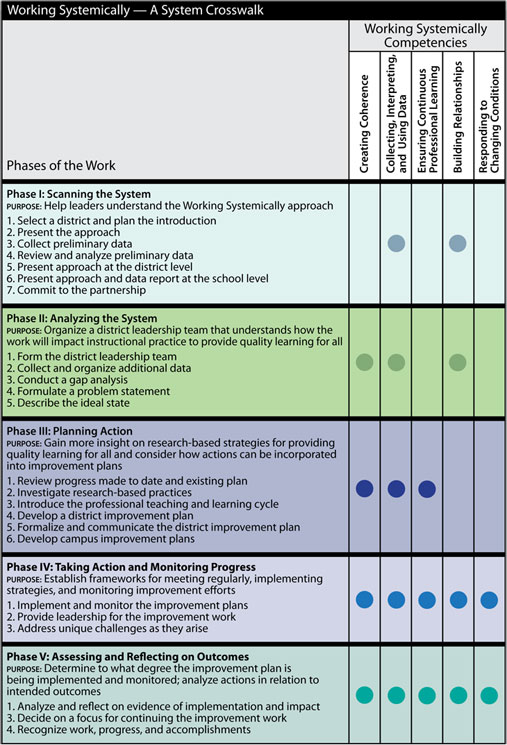The Working Systemically Approach in Action
The integrative nature of the Working Systemically approach implies a dynamic interaction among three dimensions illustrated by the cube on page 5. Components and competencies are developed at all levels of the system through a five-phase process for working with districts and schools to increase student achievement. The phases of the work are not intended as a recipe independent of contextual factors. SEDL has expanded a typical standard planning format to promote a deeper understanding of the challenges an education system faces, with a strong focus on the development and monitoring of an action plan. The five phases of the work provide a framework for transforming an education system. These phases, and their cyclical nature, are illustrated in Figure 2; the text that follows the table contains brief descriptions of the phases and the steps contained in each.

Figure 2. The Five Phases of the Working Systemically Approach
As stated previously, the facilitator helps district and school leaders develop critical competencies as he/she guides them through each phase of the Working Systemically approach. Action steps within each phase provide opportunities for the facilitator to focus more intensely on strengthening specific competencies. For example, in Phase II, Analyzing the System, leaders must develop a focus for improvement (create coherence), examine data (collect, interpret, and use data), and work collaboratively with one another (build relationships). The table below provides a guide to those competencies that receive primary focus during each phase of the Working Systemically approach.

The table on page 15 provides a guide to the competencies receiving primary focus in each phase. However, this does not mean that only those competencies indicated are being developed during any one phase. Because the Working Systemically approach is multi-faceted, recursive, and contextual in nature, opportunities will emerge throughout each phase to build the other competencies as well. The role of the facilitator is to recognize when such opportunities surface and to take advantage of them by using them as teachable moments.
Phase I Scanning the System
In this phase, the facilitator helps leaders understand the Working Systemically approach and how it can be implemented at the district and school levels. During this phase, the facilitator begins to develop the system's competencies of collecting, interpreting, and using data and building relationships. This phase of the work consists of seven steps:
- Select a District and Plan the Introduction
- Present the Approach
- Collect Preliminary Data
- Review and Analyze Preliminary Data
- Present Data Report at the District Level
- Present Approach and Data Report at the School Level
- Commit to the Partnership
Phase II Analyzing the System
The purpose of the second phase of the work is to organize a district leadership team that identifies a need in the alignment of five components of the system: alignment of local curriculum, classroom instruction, and assessment strategies to state standards and alignment of resources to support the work. In this phase of the work, the facilitator helps the district understand how the work will have a direct and positive impact on instructional practice in the classroom. The competencies of collecting, interpreting, and using data; creating coherence; and building relationships play important parts in this phase of the work. This phase consists of five steps:
- Form the District Leadership Team
- Collect and Organize Additional Data
- Conduct a Gap Analysis
- Formulate a Problem Statement
- Describe the Ideal State
Phase III Planning Action
In the third phase of the work, leaders gain more insight into what strategies research shows to be effective for increasing student achievement and consider how those actions can be incorporated into their improvement effort. Leaders also develop a detailed improvement plan that outlines action steps and the support necessary to ensure that the plan will be implemented. The key competencies developed in this phase are creating coherence and ensuring continuous professional learning.
Planning Action consists of six steps:
- Review Progress Made to Date and Existing Plan
- Investigate Research-Based Actions
- Introduce the Professional Teaching and Learning Cycle (PTLC)
- Develop District Improvement Plan
- Formalize and Communicate the District Improvement Plan
- Develop Campus Improvement Plans
Phase IV Taking Action and Monitoring Progress
In the fourth phase of the work, the focus shifts increasing from the facilitator to the district and school leaders. Leaders first establish frameworks for meeting regularly and monitoring the implementation of the improvement plans. Leaders and teachers then implement the strategies set at the district and school levels. In this phase of the work, attention is on the components of standards, curriculum, instruction, assessment, resources, and professional staff and the competencies of creating coherence; collecting, interpreting, and using data; and ensuring continuous professional learning. Throughout the implementation of the plans, leaders provide the support that is needed in order to maintain momentum and keep the effort on track. Taking Action and Monitoring Progress consists of three steps:
- Implement and Monitor the Improvement Plans
- Provide Leadership for the Improvement Work
- Address Unique Challenges as They Arise
Phase V Assessing and Reflecting on Outcomes
In this phase of the work, members of the district leadership team begin their formal assessment and reflection with a narrow focus as they determine whether and to what degree the action plan is being implemented and monitored with fidelity. They broaden their analysis as they examine whether the actions taken are resulting in their intended outcomes. Finally, leaders determine at what point in the Working Systemically approach their efforts will recycle and continue in the following school year. The competencies of collecting, interpreting, and using data and responding to changing conditions are at the forefront of the work in this phase. Assessing and Reflecting on Outcomes is divided into three steps:
- Analyze and Reflect on Evidence of Implementation and Impact
- Decide on a Focus for Continuing the Improvement Work
- Recognize Work, Progress, and Accomplishments
Next Page: The Working Systemically Facilitator


